This is the final part of the 3-part series. In part I, I discussed what I do during the first session with a client. In part II, I discussed programming considerations. In this article (part III), I will share practical tips for alleviating discomfort and preventing “battle scars” associated with glute bridging and hip thrusting.
The Hip Thruster is the best way to do the hip thrust – stable and versatile!
Since Kellie Davis and I wrote Strong Curves, I’ve noticed a huge increase in the number of pictures, videos, and comments pertaining to barbell glute bridges and hip thrusts on various social media sites. From time to time, I see women who proudly show off the “battle scars” (bruises and scrapes) that they earned while doing heavy glute work. However, these nuisances, along with other injuries, need not occur. One can easily bridge and thrust away comfortably as long as proper precautions are taken and special attention to form is given. Below are solutions to common heavy glute training problems.
Problem #1: Wrist Pain & Discomfort
Experiencing wrist pain during barbell bridges and hip thrusts seems to be more common with women than men, probably due to their smaller wrist structures. This usually happens during the combination of wrist hyperextension and excessive “pushing” on the barbell. The solutions are to 1) keep the wrists in neutral and not allow them to hyperextend, and 2) make sure to keep the barbell centered directly over the hips – don’t roll the bar forward as the hips rise.
Don’t do This

Do This

Problem #2: Hip Bruises
This might be the most common problem associated with glute bridging and hip thrusting. Many individuals experience bruising in the hip region where the bar meets the body. The solution here is to use ample bar padding. I’ve had success with both the Hampton thick bar pad and the Airex Balance Pad. While this is usually sufficient for the strongest of males, some of the strongest women will sometimes bruise even when using padding. Thick bars can be useful in this case, but in general more padding is needed, so get creative!
Don’t do This

Do This

Problem #3: Upper Back Scrapes & Burns
Upper back burns and scrapes can occur with barbell glute bridging due to friction across the floor surface as well as with barbell hip thrusting due to digging into the bench. The solution is to 1) make sure you’re wearing a shirt (no sports bras), and 2) consider utilizing padding. For barbell glute bridges, this means using a yoga matt or other matting such as an Airex Balance Pad, and for hip thrusts it means using a bench with ample padding (we designed The Hip Thruster to be very comfortable in this manner as the padding wraps all the way around the front of the bench).
Don’t do This
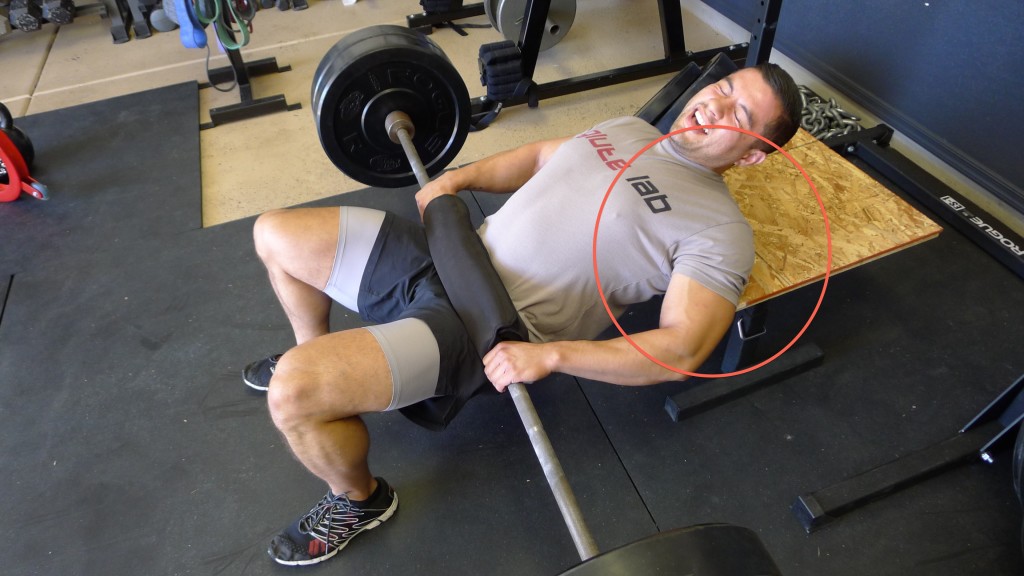
Do This

Don’t do This

Do This
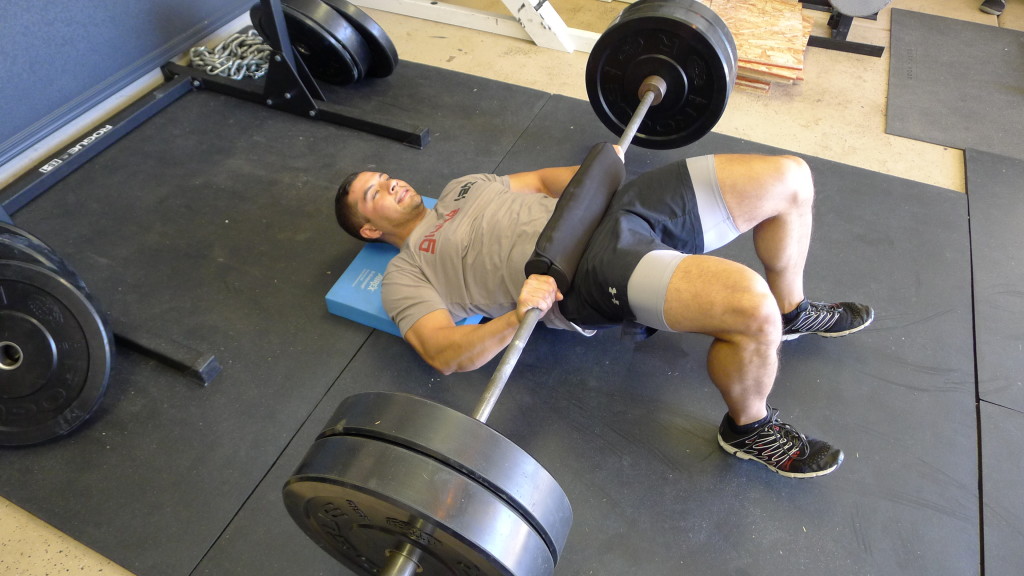
Problem #4: Hip Pain
From time to time, lifters might experience pain inside the body, coming from the anterior hip capsule, when bridging or thrusting. This can happen if the individual relies upon the hamstrings primarily for hip extension rather than the glutes, and it’s exacerbated when the lifter bridges the hips into full spinal and hip hyperextension. Make sure to 1) push the hips upward with the glutes, 2) not go too heavy to where the tension isn’t felt on the glutes, and 3) keep the torso flat and avoid hyperextension of the spine and hyperextension of the hips (hip hyperextension is okay for most individuals though, just not with folks who experience anterior hip pain – lifters with anterior hip pain should cut the last few inches of the lockout short).
Don’t do This
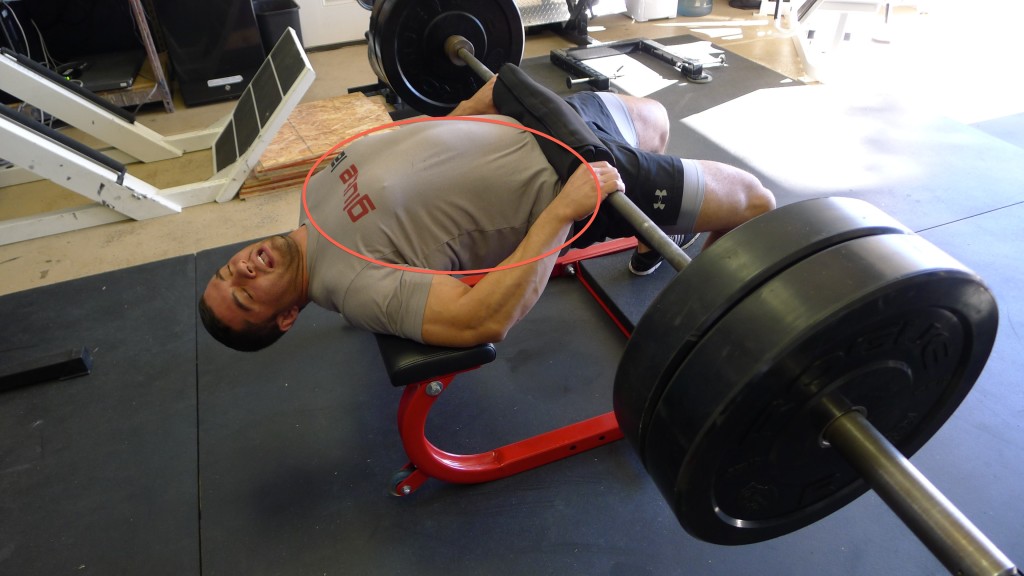
Do This
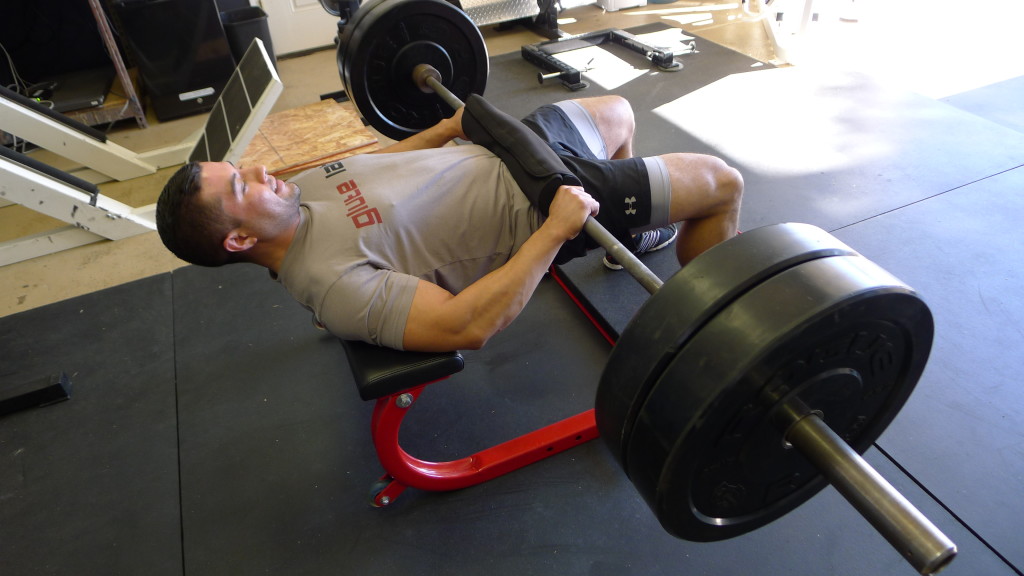
Problem #5: Low Back Pain
Low back pain is probably the second most common problem associated with heavy bridging and thrusting, next to hip bruising. This primarily occurs when lifters overarch (hyperextend) their spines, and it’s usually accompanied by excessive anterior pelvic tilt. Click HERE to read more about why this occurs. The solution is to keep the torso flat (some coaches say to keep the ribcage down).
Don’t do This

Do This

Problem #6: Knee Pain
This problem typically arises when lifters hip thrust very frequently. Since the quadriceps contract very hard during the hip thrust, the tension can create pain in the quadriceps (typically the vastus lateralis), in the quadriceps tendon, or in the patellar tendon. The solutions are to 1) reduce hip thrusting frequency, 2) alternate between glute bridging (which utilizes less quadriceps muscle) and hip thrusting, and 3) avoid pushing the body so hard into the bench with the quads (pushing the feet away from the bench), and 4) avoid having angled tibias at the lockout (bring the feet closer in so that the shins are vertical at lockout).
Don’t do This

Do This
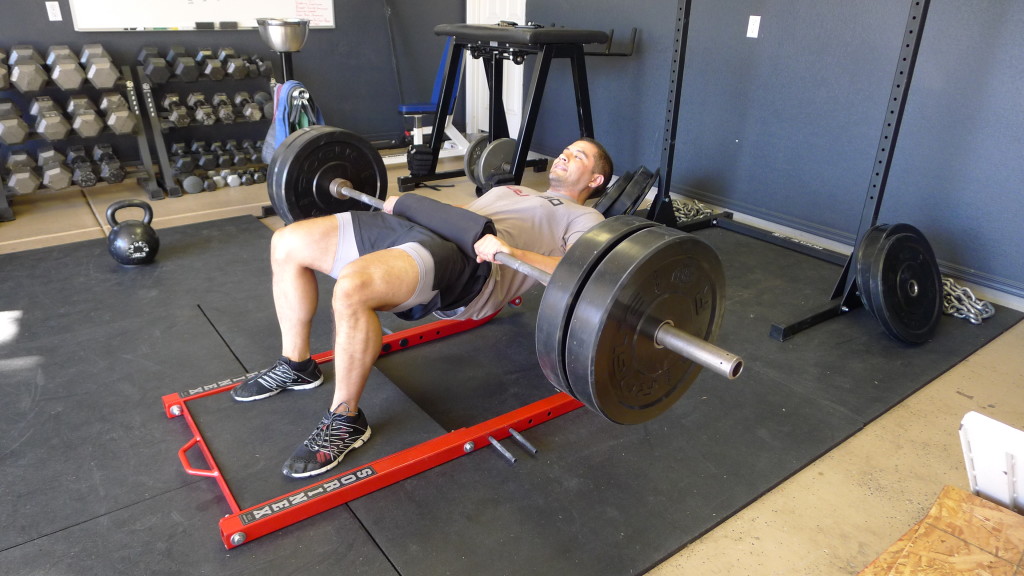
Problem #7: Neck Pain
Some lifters experience neck pain when hip thrusting, and this is due to improper strength endurance in the neck, along with poor positioning. Many lifters flex and extend their necks while hip thrusting and don’t find it to be problematic. Others will find that their necks cramp up and “give out” before the glutes do, especially during high repetition sets. The solutions are to 1) hold better neck position by keeping the neck in a more neutral posture (click HERE to learn about neck-packing), 2) consider performing specialized neck exercises in order to gain more endurance (ex: supine neck flexion and extension off of a foam roller), and 3) consider placing a cushion to rest the head upon on top of the bench, which will unfortunately place the neck in a bit of extension at the bottom of the movement, but it will cure the neck cramping.
Don’t do This

Do This

Problem #8: Hamstring Cramping
Hamstring cramping is very common during bridging and thrusting, especially at first when the lifter first starts performing them. This has a lot to do with unfamiliarity, as most lifters are accustomed to using the hamstrings at longer lengths (the hamstrings are shortened due to the bent knees in a hip thrust). The solutions are to 1) make sure you rely upon the glutes and ease into the exercises, 2) avoid going too heavy to the point where form breaks down and the spine hyperxtends and the pelvis anteriorly rotates, and 3) consider experimenting with various SMR/foam rolling/dynamic stretching/static stretching protocols prior to glute bridge and hip thrust performance.
Don’t do This

Do This

Conclusion
As you can see, hip thrusting (and glute bridging) can be a very pleasurable experience as long as you take necessary precautions and utilize proper form. It should be mentioned that every body is unique, and that tinkering and experimentation is needed to find ideal solutions for each lifter’s particular anatomy, physiology, and logistics. Feel free to share what’s worked for you in the comments section below. I hope you enjoyed the content, the pictures, and the entire 3-part series for that matter! That’s all for now.

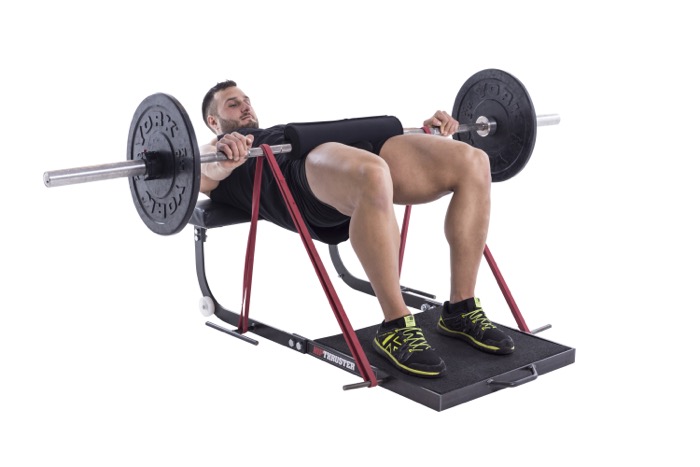





You all look like your having way to much fun in the glute lab!
What could be going wrong if you get pain (not glute soreness) in the back of the hips when walking the day after glute bridges?
Mathiah – I’m assuming it’s muscular pain? Is this lower glute/upper hamstring region, or hip external rotator region, etc.? Would need to know the exact area, but I’d think this would be muscular and not capsular or ligamentous though.
Another way to reduce hamstring cramping when hip thrusting or bridging is to attempt to push yourself with your legs as if you were trying to slide cephalically. This can turn down or off the hamstrings thru reflex inhibition. I use this successfully with many patients in a physical therapy setting.
One thing I noticed is when I come up to lock out, the bar rests right up against my pubic bone. (It hurt at first when I wasnt using sufficient padding). If I try to thrust with the bar BETWEEN my hip bones and pubic region, I don’t feel the glute burn as much compared to when the bar sits right up against my pubic bone (my arms are fully extended, also). I realize this is not ideal for males, since they obviously have a bit more to worry about in that region, and a loaded barbell may not generate the best of feelings when it’s lodged up against that area) Would it make a difference if the load is a little bit closer to my glutes? I mean it’s not THAT much closer- 1/2 inch at the most, but I feel like when the bar is down there it drops a bit. Thoughts?
Also, Mathia, do you mean your lumbar is where you’re feeling sore? Maybe it could be because when you thrust, you are going into APT (anterior pelvic tilt) and your glutes aren’t doing the work ? Problem # 5, maybe? Also I know Bret put out a really good article on this and even though I’ve never felt bridging or thrusting in my lumbar, this helped me to understand the glutes and PPT and the importance of locking out and isoholding it at the top. It took my glute pump to a whole new level. Actually Ill find that article for you.
http://bretcontreras.com/anterior-pelvic-tilt-and-lumbosacral-pain-as-it-relates-to-the-hip-thrust-and-glute-bridge/
I had to read it through about 3-4 times to really absorb the information. I would always see the words anterior/posterior pelvic tilting and had no idea what was going on, and when I stumbled across this, I thanked the good Lord! (and you too, Mr. Author 😛 )
I hope this helps. 🙂
Hailey, if you can get away with this, then yes, it’s ideal. The more centered over the glutes, the higher the glute activation and greater the loading on the glutes will be. Good instincts!!! BC
This is very informative Bret, thank you! The photos are very entertaining as well.
Great stuff as always. One of the best tips I got from you (besides adding glute training) was the Hampton thick bar pad. I was able to add over 100 pounds to my hip thrust, and with less pain.
One thing you didn’t mention was “I can barely walk afterwards and I feel like I’m going to hulk out of my jeans.” Maybe you can cover that next time….
Haha! Good call Dunkman 🙂
It’s not pain in the lumbar, it feels like my glutes are trying to yank my leg out of the socket almost. I actually find it INCREDIBLY hard to get into APT.
Hmmm. I guess I’d need more info – is this pain muscular? I’ve always said that one cannot have too strong of glutes! But you might benefit from strengthening other muscles, such as the erectors, hip flexors, and hammies. Need more info.
It is muscular, sorry for not repyling sooner, I assume that you’ve paired Glute work with some form of Hip Flexor work to balance it out and that’s why you don’t run into that problem.
That is how I have tried to handle the problem and it has worked as far as I can tell, but I was mostly wondering if you had run into that type of problem and if you had a particular way you went about fixing it. It seems you did as your guess was exactly how I went about it and that has worked.
I have read many of your articles ranging from your blog to EFS and T-Nation and you I never saw you address the possibility of your glutes actually being too strong. To clarify though, if using force couples you would strengthen the Hip Flexors to counter strengthening the Glutes from an APT vs. PPT standpoint correct?
Would you ever consider doing an article on that? 🙂
This post is an example of why I love your site so much and keep coming back — practical solutions to problems, explained clearly and in detail, with photos (in this case, very amusing photos!).
Thank you so much for sharing your extensive knowledge with the rest of us!
I LOVE the Glute Lab t-shirts… Where can I find one!?
Am I old-school for still sporting my red Skorcher t-shirt that I got at the ACE Fitness Symposium in Las Vegas?!
Michael we don’t have shirts yet. If I knew people would want their own then I’d have designed a cooler logo! Let me think about this. And props to you for having an old-school Skorcher shirt haha!
Maybe you’ve already addressed this, but please give some advice on how to handle the people that stare. I’ve tried doing hip thrusts at my gym a couple if times only to have dudes stopping to watch . Embarrassing!!!
LOL! Well, the dudes probably aren’t staring at me the exact same way they are with you, but I know how much unwanted attention you can receive while doing your hip thrusts. Every time I do my thrusts some know-it-all walks up and says “that looks like a tough ab routine” or when I reply that it works glutes and hams they reply, “you should just do some squats”. Or the one I like best is when some guy with his lats flared out asks if I’m an athlete or something and can’t understand why I’m working out so hard and perspiring in gym!? Ha!
I like to think of those moments as educational opportunities. The poor folks have been given partial information by the pop magazines, influenced by a hypocritical steroid bodybuilding culture, and driven by just plain ole’ male insecurity and ego! I look at the staring and attention and comments as just genuine ignorance and lack of exposure. Maybe we can play a small role in re-shaping the country!
I’m the same way Michael! I view them as educational opportunities. And usually I follow hip thrusts up with deadlifts, so people take me more seriously because they see my deadlift strength. And I’ve had people think they’re ab exercises and just say to squat too! Interesting how poor some lifters’ biomechanical instincts are. To me it’s obviously strengthening bent leg hip extension which would target the glutes.
Bret,
We need a dialogue for this. I work in an Army gym! It took me weeks to work up the courage to try hip thrusts. Now I do them regularly and still get funny looks and stares. I try to face a wall…no eye contact here! Last week, someone asked me if I ‘invented’ the exercise.
Hahaha! Diane, in time no one will think it’s strange. Print out a few copies of this post and hand it to any hater who speaks out:http://bretcontreras.com/hip-thrust-and-glute-science/
Stay the course and keep preaching the glute gospel!!1 🙂
Marquita – you just don’t make eye contact! http://instagram.com/p/elHHcwJdBk/
Seriously, I know it’s a bit embarrassing, but it’s a relatively new exercise and it might be the first time people are seeing it. Also, just take it as a compliment!
Great article series, these were extremely informative.
Hi Bret,
Great tips for making our thrusting experience more safe and comfortable.
I have a question about glute bridges. Should you go all the way down with the glutes when performing them? I use plates with big diameter, and it creates a gap between my butt and the floor when I go down.
Do you take new online clients? Or better question, do you have time for new clients? 🙂
Polina, great question. In your case, no don’t go all the way down. Limit it slightly to keep constant tension on the glutes. You’ll probably have to reset throughout the set once or twice unless you can stay into position (I never do…my feet slide away a bit). If you had a Hampton thick bar pad, this distance between floor and hips would diminish. Also, you could use 35 lb plates. I’m not taking on new clients and don’t do online training…too busy with PhD. Sorry to disappoint! BC
My tips:
1) If using the squat ‘puss pads’, use 2 ( 1 on each side). This covers the hips better.
2) For wrist or low back pain, try a supinated grip. Start with a lighter weight ( like a warm up weight), and before the first rep, try to activate your lats. If done properly, this will shift the load from the low back to the abs. This gets more difficult when the weight increases, and needs practice. Strong glutes do not matter if you throw out your back!
3) For glute bridges, always use a yoga pad. I went without once; My gym floor scratched the hell out my back; I had nicks and cuts that were bleeding. Never again!
Cheers
Great tips Alex!!! Thank you for chiming in, I appreciate it!
The most helpful advice I heard was when kellie described pulling your pelvis up to your rib cage in the lockout ….. First time I really felt glutes engage without over extending
Thank you for the information, it is very helpful, I started with the sets suggested for mon, wed and fri,, and I got a hamstring Cramping just in one of the leg (left one). I don’t know if because it is my weak body side probably? I stopped to train two days,, feels better but I am still feeling the pain although
I’ve just started to include Barbell Glute Bridges to my powerlifting programming and I got a very annoying pain in my patellar tendon….Had stay away from squats and deadlifts for at least one week! It sucks… Solution? I’ll have to think about it…
This is really helpful! The photos are totally hilarious!
Hi Bret
Do you have any hip thrust, hip extentions and glute Bridge workouts which can be done without equipment??
I fall under the many who cant afford gym subscription and made my own gym equipment.
i do squats, lunges, dead lifts however also have issues with getting my glutes to work properly.
Hey bret! i have gotten my girlfriend doing glute bridges for a while, and she has seen great results. She has gotten up to 90kg on them, but after she’s done with the exercise she says she feels a sharp pain somewhere inside (as in, not in the surface) of her upper glutes. Sometimes it keeps hurting when she bends over when she opens/closes her legs. The pain doesn’t irradiate, and it doesn’t hurt to sit down and get up. It usually goes away after a day, sometimes more.
After the glute bridges she also squats and does side lying hip abductions, and she feels no pain at all during of or after these exercises (she used to do deadlifts after as well, but it started hurting too). I’m going to have her stop doing glute bridges for the rest of the week and try to ease into it and pay extra attention if she’s overarching her spine next session, but I’m not so sure since the pain isn’t in the lower back or very close to the spine.
When performing the glute bridge, I find it hard to balance the bar when I’m thrusting as high as I can go and I’m not sure if im lifting too heavy or what? I’m doing 120 lbs on the bar right now. If I cut the weight down, will it cause muscle atrophy or will it be more effective for muscle growth?